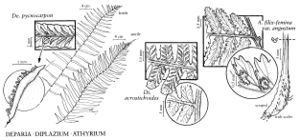Deparia
Icon. Filic. 2(8). 1829.
| Taxon | Illustrator ⠉ | |
|---|---|---|
 | Athyrium filix-femina var. angustum Deparia acrostichoides Diplazium pycnocarpon | John Myers John Myers John Myers |
Plants terrestrial. Stems creeping, stolons absent. Leaves monomorphic, dying back in winter. Petiole 1/3–2/3 length of blade, base swollen and persisting as trophopod over winter or not; vascular-bundles 2, lateral, lunate in cross-section. Blade elliptic to ovatelanceolate, 1-pinnate-pinnatifid [pinnatifid to 3-pinnate-pinnatifid], gradually reduced distally to pinnatifid apex, herbaceous. Pinnae not articulate to rachis, segment margins entire, crenulate, or serrate; proximal pinnae (several pairs) reduced or not, sessile, equilateral; costae adaxially shallowly grooved, grooves not continuous with that of rachis; indument on rachis and costae (both sides) of multicellular hairs. Veins free, simple or forked. Sori on veins, elongate, ± straight, or hooked at distal end; indusia linear, laterally attached, persistent. Spores brownish, broadly winged. x = 40.
Distribution
North America, e Asia, se and tropical Africa including Madagascar, Pacific Islands, Australia
Discussion
Petiole bases are swollen and toothed in sect. Lunathyrium (Koidzumi) M. Kato but not or only slightly thickened and without teeth in sects. Athyriopsis (Ching) M. Kato, Deparia, and Dryoathyrium (Ching) M. Kato.
Two American species, one native and the other introduced, are usually placed in Athyrium or Diplazium. The genus Deparia, however, including these two species, is sufficiently distinct to warrant generic separation because of its nondecurrent costal grooves and the presence of multicellular hairs on blades (M. Kato 1984).
Species ca. 50 (2 in the flora).
Selected References
Lower Taxa
Key
| 1 | Leaves markedly narrowed to base; petiole bases swollen and dentate. | Deparia acrostichoides |
| 1 | Leaves not or only slightly narrowed to base; petiole bases neither markedly swollen nor dentate. | Deparia petersenii |
"/3lengthofblade" is not declared as a valid unit of measurement for this property.